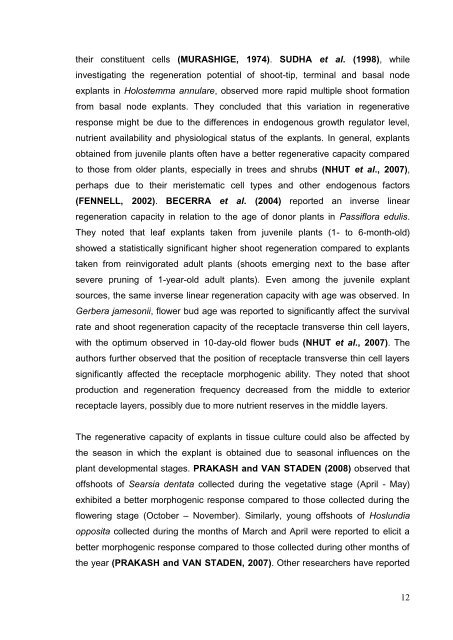Micropropagation and medicinal properties of Barleria greenii
Micropropagation and medicinal properties of Barleria greenii
Micropropagation and medicinal properties of Barleria greenii
Create successful ePaper yourself
Turn your PDF publications into a flip-book with our unique Google optimized e-Paper software.
their constituent cells (MURASHIGE, 1974). SUDHA et al. (1998), while<br />
investigating the regeneration potential <strong>of</strong> shoot-tip, terminal <strong>and</strong> basal node<br />
explants in Holostemma annulare, observed more rapid multiple shoot formation<br />
from basal node explants. They concluded that this variation in regenerative<br />
response might be due to the differences in endogenous growth regulator level,<br />
nutrient availability <strong>and</strong> physiological status <strong>of</strong> the explants. In general, explants<br />
obtained from juvenile plants <strong>of</strong>ten have a better regenerative capacity compared<br />
to those from older plants, especially in trees <strong>and</strong> shrubs (NHUT et al., 2007),<br />
perhaps due to their meristematic cell types <strong>and</strong> other endogenous factors<br />
(FENNELL, 2002). BECERRA et al. (2004) reported an inverse linear<br />
regeneration capacity in relation to the age <strong>of</strong> donor plants in Passiflora edulis.<br />
They noted that leaf explants taken from juvenile plants (1- to 6-month-old)<br />
showed a statistically significant higher shoot regeneration compared to explants<br />
taken from reinvigorated adult plants (shoots emerging next to the base after<br />
severe pruning <strong>of</strong> 1-year-old adult plants). Even among the juvenile explant<br />
sources, the same inverse linear regeneration capacity with age was observed. In<br />
Gerbera jamesonii, flower bud age was reported to significantly affect the survival<br />
rate <strong>and</strong> shoot regeneration capacity <strong>of</strong> the receptacle transverse thin cell layers,<br />
with the optimum observed in 10-day-old flower buds (NHUT et al., 2007). The<br />
authors further observed that the position <strong>of</strong> receptacle transverse thin cell layers<br />
significantly affected the receptacle morphogenic ability. They noted that shoot<br />
production <strong>and</strong> regeneration frequency decreased from the middle to exterior<br />
receptacle layers, possibly due to more nutrient reserves in the middle layers.<br />
The regenerative capacity <strong>of</strong> explants in tissue culture could also be affected by<br />
the season in which the explant is obtained due to seasonal influences on the<br />
plant developmental stages. PRAKASH <strong>and</strong> VAN STADEN (2008) observed that<br />
<strong>of</strong>fshoots <strong>of</strong> Searsia dentata collected during the vegetative stage (April - May)<br />
exhibited a better morphogenic response compared to those collected during the<br />
flowering stage (October – November). Similarly, young <strong>of</strong>fshoots <strong>of</strong> Hoslundia<br />
opposita collected during the months <strong>of</strong> March <strong>and</strong> April were reported to elicit a<br />
better morphogenic response compared to those collected during other months <strong>of</strong><br />
the year (PRAKASH <strong>and</strong> VAN STADEN, 2007). Other researchers have reported<br />
12

















